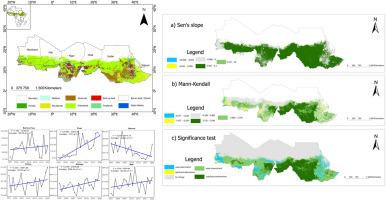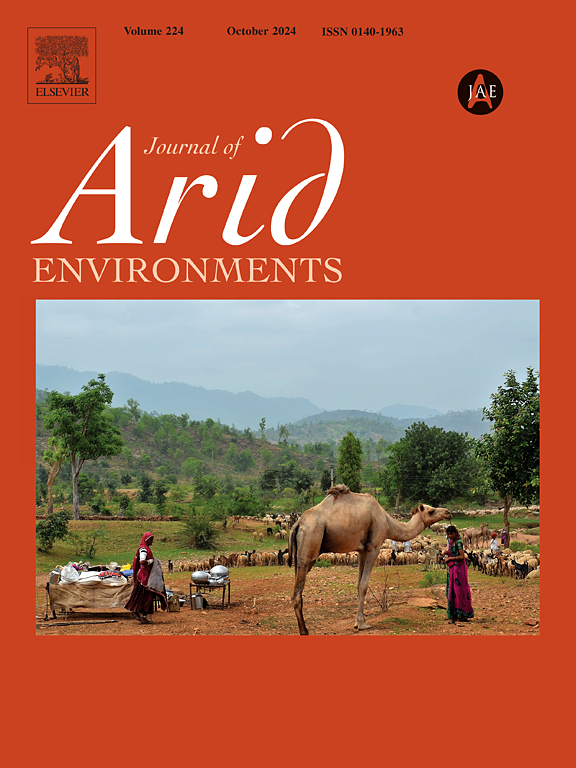Spatial and temporal patterns and driving factors of carbon in green great wall project, Africa
IF 2.5
3区 环境科学与生态学
Q2 ECOLOGY
引用次数: 0
Abstract
Net Primary Production (NPP) is a critical indicator of vegetative growth status, carbon sequestration capacity, and overall terrestrial ecosystem productivity, thereby contributing significantly to global ecological stability. In the Africa Sahel region, as well as the largest ecological project in Africa——The Green Great Wall, characterized by diverse and dynamic ecosystems, the quantification of vegetation degradation and NPP variability remains limited and uncertain. Therefore, this study provides substantiating evidence to support the enhancement and preservation of vegetative ecosystems in the Sahel region by analyzing spatial and temporal variations in NPP and its driving factors from 2001 to 2020. The Theil-Sen median and the Mann-Kendall significance test were employed to evaluate the NPP spatio-temporal patterns, while the geographical detector model was implemented to measure the influence of environmental variables within the Great Green Wall corridor. We found that the NPP exhibited an upward trend, with 121.97 gC m−2 annual average between 2001 and 2020. Over the past two decades of the Green Great Wall Project, approximately 40 % of the region exhibited an increase in NPP, 7 % experienced a decline, while 53 % remained desert or bare land. Spatially, the highest observed NPP was recorded in Ethiopia at 556.23 gC m−2 yr−1, while the lowest value observed was in Niger at 0.43 gC m−2 yr−1. The geographical detector analysis indicated that temperature and precipitation emerged as the dominant climatic driver of NPP variability, while interaction analysis revealed that the combined influence of precipitation and temperature had the strongest effect on NPP dynamics during the study period. Our findings offer regional evidence for evaluating the benefits of forestry ecological projects in arid zones, contributing to enhanced ecological well-being and resilience in Africa, and providing valuable insights for advancing the Sustainable Development Goals.

非洲绿色长城工程碳排放时空格局及驱动因素
净初级生产力(NPP)是衡量植被生长状况、固碳能力和陆地生态系统整体生产力的重要指标,对全球生态稳定性有重要贡献。在非洲萨赫勒地区,以及非洲最大的生态工程“绿色长城”,以生态系统的多样性和动态为特征,植被退化和NPP变率的量化仍然有限和不确定。因此,本研究通过分析2001 - 2020年NPP的时空变化及其驱动因素,为支持萨赫勒地区植被生态系统的增强和保护提供了实证证据。采用Theil-Sen中值和Mann-Kendall显著性检验评价NPP的时空格局,采用地理探测器模型衡量绿色长城走廊内环境变量的影响。结果表明,2001 ~ 2020年NPP呈上升趋势,年平均为121.97 gC m−2。在绿色长城工程实施的20年间,约40%的区域NPP增加,7%的区域NPP下降,而53%的区域仍为沙漠或光秃秃的土地。在空间上,埃塞俄比亚观测到的NPP最高,为556.23 gC m−2 yr−1,尼日尔观测到的NPP最低,为0.43 gC m−2 yr−1。地理探测器分析表明,温度和降水是NPP变化的主要气候驱动因子,而交互作用分析表明,降水和温度对NPP变化的综合影响最为强烈。我们的研究结果为评估干旱地区林业生态项目的效益提供了区域证据,有助于提高非洲的生态福祉和恢复力,并为推进可持续发展目标提供了有价值的见解。
本文章由计算机程序翻译,如有差异,请以英文原文为准。
求助全文
约1分钟内获得全文
求助全文
来源期刊

Journal of Arid Environments
环境科学-环境科学
CiteScore
5.70
自引率
3.70%
发文量
144
审稿时长
55 days
期刊介绍:
The Journal of Arid Environments is an international journal publishing original scientific and technical research articles on physical, biological and cultural aspects of arid, semi-arid, and desert environments. As a forum of multi-disciplinary and interdisciplinary dialogue it addresses research on all aspects of arid environments and their past, present and future use.
 求助内容:
求助内容: 应助结果提醒方式:
应助结果提醒方式:


